The prevailing story of synthesizer production in the 1980s is tumultuous. While the rapid introduction and integration of new digital technologies meant an equally rapid advancement in the art of instrument design, it also meant that some long-standing companies were not entirely able to keep up with the demands of the modern musical landscape. The advent of affordable and flexible digital synthesis, stripped-down polysynths, and sampling meant that knob-per-function, fully-featured analog synthesizers were quickly outmoded.
During this period, several companies focused on producing pared-down versions of their previous synthesis concepts, realizing that the spirit of instruments like the DX-7 was overtaking the market. The DX-7 was affordable, polyphonic, and provided instant access to a wide variety of sounds, even if editing its tones was a bit of a slog. So many smaller (but foundational) synth companies began to follow suit and produced affordable, simple instruments that for the most part failed to fully capture the public's attention. And as such, instrument makers like Moog, Sequential Circuits, and ARP one by one closed their doors as Yamaha, Roland, E-Mu, and others took the helm.
And while Oberheim certainly produced their fair share of preset-style keyboards and sound modules, they had faith that there was still room in the market for powerful, well-made analog synthesizers. And, despite the fact that their own days were numbered, they developed two particularly special, would-be cult classic synthesizers: the Xpander and Matrix-12.
The Oberheim Xpander
The Oberheim Xpander was introduced in 1984: a hyper-flexible, desktop-format sound module with six analog synth voices inside (with digital memory and modulation capabilities). In some ways, the Xpander is an extension of Oberheim's older SEM (Synthesizer Expander Module) concept: it was intended to extend the capabilities and sound palette of other instruments.
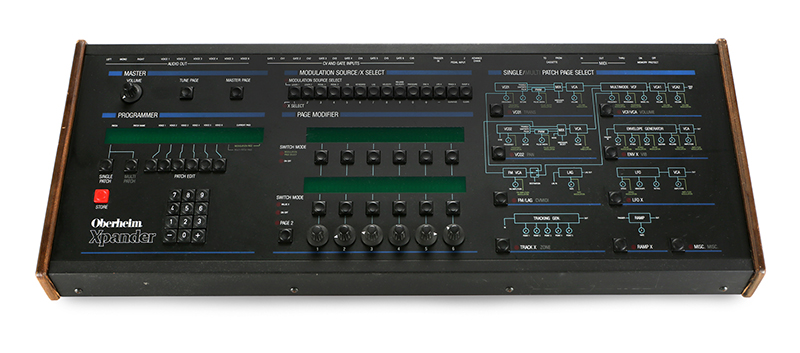
Unlike the strictly analog SEM, though, the Xpander was one of the first notable standalone sound modules which integrated MIDI protocol. Most MIDI-capable devices at the time were full keyboard instruments, and few manufacturers had yet considered the potential for manufacturing instruments which were intended to be played from other control sources. This foreshadowed the development of rackmount sound modules and MIDI controllers as divergent classes of device in the electronic music industry—though as we'll soon see, the Xpander was far more capable than the average Rompler. It also featured CV and Gate inputs for each individual voice, so interfacing with older analog equipment was straightforward. The Xpander could be paired with the Oberheim Xk, a MIDI keyboard controller with Oberheim's famous pitch bend and modulation levers.
The Xpander, though powerful, is a notoriously complex synthesizer—even well after its release, Keyboard Magazine and other outlets offered in-depth resources dedicated to patch tips and definitions of some of its more esoteric functionality. It eventually became a cult classic, still prized for its remarkable sonic breadth, capable of everything from huge basses to lush polysynth brass and strings all the way to complex, animated textures reminiscent of a modular synth. But the Xpander, of course, wasn't Oberheim's only ambitious instrument of the 1980s—and wasn't the only member of its family.
The Oberheim Matrix-12
In 1985, the Matrix-12 was introduced to the public. The Matrix-12 is essentially two Xpanders in a single chassis, with an added keyboard and pitch bend/modulation paddles. It's important to note how out of place the Matrix-12 was in its time: it was large, complex, analog, and relatively expensive. Up against competition like the Juno-106 and DX-7, the Matrix-12 came across as a bold statement that powerful, analog designs were still valuable, and that fully-featured, open-ended instruments still had a place in the musical marketplace. At a retail price of over $6000 USD at its introduction, it was not unlike a relic from a bygone era, in which electronic instruments were no-compromise, large, handmade artisanal artifacts for studios, schools, and other well-funded benefactors.
Because of this, many see the Matrix-12 as the last great analog polysynth of the 1980s. Within a few years after its introduction, Oberheim went out of business, only to be acquired by Gibson and never again to produce an instrument with quite the power or reputation of the Matrix-12 or Xpander (though the OB-12 and OB-Mx are, of course, interesting synths with their own interesting stories). But what makes these particular synthesizers so unique? In a world with so many analog polysynths, why were these so prized?
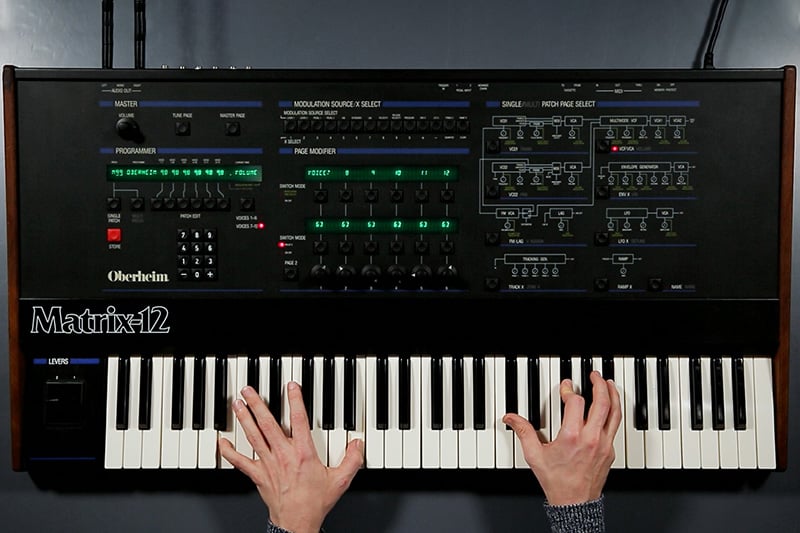
The Matrix-12 is a 12-voice analog synthesizer with digital modulation and digital control. Each voice contains a staggering number of resources: two oscillators, a noise generator, a 15-mode filter, an FM modulation generator, five envelopes, five LFOs, a lag processor, three tracking generators, four ramp generators, and a generous helping of VCAs (don't worry if some of these terms are unfamiliar—we'll get to them soon). And while some aspects of the voice signal path are fixed, most modulation paths are freely assignable, offering a level of flexibility uncommon in standalone synthesizers then and now.
The key to the Matrix-12 and Xpander's internal organization is a modulation matrix: a digitally-controlled signal routing system that connects the synthesizer's various internal modules to one another via user-defined paths. This isn't unlike the pin matrix on an EMS VCS3 or Synthi...and isn't unlike the way a modular synthesizer works, just without the clutter of physical cables and adding the advantage of patch memory. This makes it such that the majority of the parameters of interest become available to virtually any interesting modulation source...down to a level of control uncommon even in many modular synths.
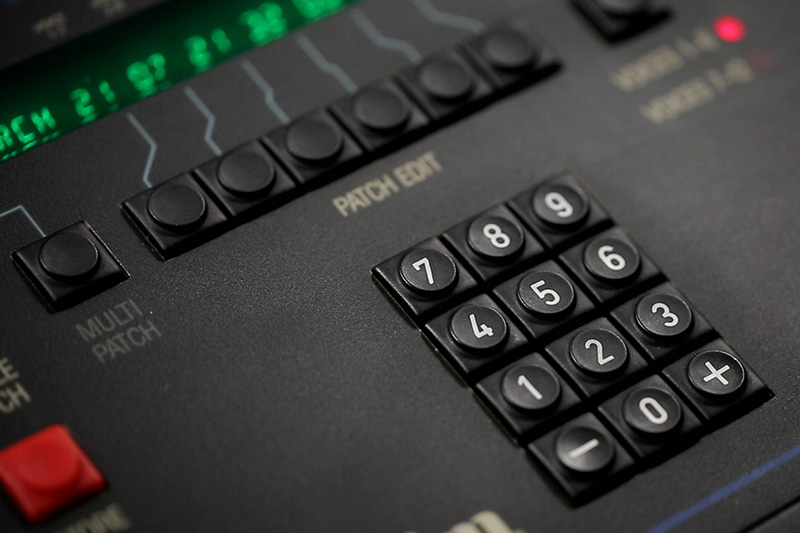 Patch editing facility on the Oberheim Matrix-12
Patch editing facility on the Oberheim Matrix-12
There are, of course, downsides to this design. One of the most obvious is that the more complex your patches become, the harder it is to keep track of everything that is going on. Without being able to see the "virtual patch cables," it can be easy to forget exactly how the internal modules are currently interacting with one another. Moreover, since these instruments do not have dedicated physical controls for any parameter of the sound, many "instincts" you develop as a synthesist are not immediately within reach. The Matrix-12 is navigated using a series of buttons that access the parameters associated with each module—for instance, if you press the VCO1 button on the right side of the synthesizer's panel, the centrally-located 40-character displays reveal the parameters available for VCO1 (detune amount, pulse width, volume, etc). The buttons and six large encoders near the displays are used to edit the parameters of the currently displayed page in stepped segments. So there's no impulsive tweaking of filter cutoff on this synth, for instance. Even once you make it to the appropriate filter page, turning big, chunky stepped encoders isn't the most seamless-feeling way to add inflection to your sound.
Those (necessary) compromises aside, these synths are still a pleasure to play—they just take some getting used to, and don't necessarily provide easy access to every idiomatic synth technique. What they lack in programming immediacy, though, they well make up for in flexibility and sound. So that in mind, let's dig deeper into each section of the Matrix-12 to find out a little more of what it's all about.
Oscillators, Lag, and FM
The Matrix-12 has two analog VCOs per voice. The first edit page for each VCO provides controls for Frequency (an offset from the key pitch, defined in semitones), Detune (up to a quarter-tone flat / quarter-tone sharp), Pulse Width, and Volume (going to the filter). The second page includes the actual waveform selection—each oscillator produces triangle, saw, and pulse waves, and can send any combination of these waveshapes to the filter simultaneously. From this screen, the oscillators may be decoupled from the keyboard, and may be set to react to the two performance levers much like a standard pitch bend or vibrato modulation wheel. VCO2 can additionally be hard synced to VCO1, allowing for classic sync sweeps and the creation of more complex waveforms.
The oscillators' second page also provides access to an option called "lag," which enables portamento and glissando effects from the synthsizer's multi-purpose lag generator. While most synthesizers' lag generators are permanently set up between the keyboard and oscillators, though, the Matrix-12 allows you to choose any of the internal modulation sources as the input to the lag generator—enabling a means of applying slewed FM effects from the LFOs, envelopes, or any other modulation source. One of the most interesting features here is that lag can be selected or deselected for each of the two oscillators independently—meaning that you can create effects where one oscillator instantly jumps to new pitches while the other more lazily glides to new notes. This becomes especially interesting when used in conjunction with oscillator sync or FM.
The Matrix-12 provides the option for FM in which VCO2 is used as the modulator and VCO1 as the carrier. FM settings can be accessed by pressing the FM/Lag button on the right side of the panel below VCO2. The FM AMP parameter (FM Amplitude) controls the depth of FM from the second oscillator's triangle wave. For particularly interesting effects, the FM intensity itself can be modulated from any of the internal modulation sources, making for expressive, dynamic FM patches that change in sonic complexity as they progress through time.
Interestingly, the Matrix-12 provides an additional option for FM destination: the VCF's cutoff frequency. You can only modulate either VCO1 or the VCF from VCO2 at any given time, each with its own distinct sonic flavor. But this brings up an interesting question...what exactly is going on with the Matrix-12/Xpander VCF?
VCF and VCA
The Xpander/Matrix-12 filter is one of the most interesting filter designs from the 1980s. While many synths of the era featured only a lowpass filter or a highpass filter and lowpass filter in series, these synthesizers' filters feature four filter poles, available in fifteen distinct combinations that produce effects from standard lowpasses to combined filter types, phase shifting, and more. The Matrix-12 filter section isn't just about choosing between lowpass, bandpass, or highpass—it's about selecting from a wide range of distinct sonic flavors.

In simple terms, the number of poles on a filter determines the slope of frequency attenuation beyond the cutoff frequency. Each pole filters by 6dB per octave; so a two-pole design has 12dB/Oct slope, three-pole has 18dB/Oct, and so forth. The effect of a one-pole filter is gentle, only slightly rolling off frequencies beyond the cutoff, whereas a four-pole filter is quite dramatic (and therefore great for bassy sounds which need not occupy too much high-end spectral space). With the choice of selecting between several different pole configurations for most filter types, the Matrix-12 provides many different ways to color and sculpt the raw oscillator sound. These include several different low pass, high pass, band pass, and notch modes, as well as some more idiosyncratic filtering options.
Low pass modes include one, two, three, and four-pole options for a wide variety of tones. High pass modes include one, two, and three-pole options, and bandpass modes include two and four-pole options. There is also a two-pole notch/band reject mode, great for hollowing out particular frequency ranges and somewhat phaser-like effects when swept.
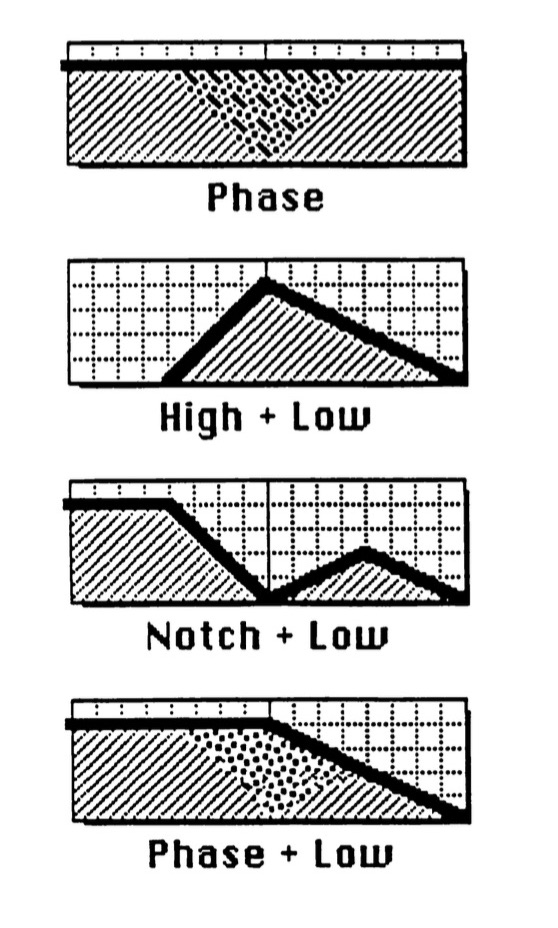 Novel filter types from the Matrix-12 manual
Novel filter types from the Matrix-12 manual
Beyond these fairly basic (albeit extensive) filter options, the Matrix-12 includes several more novel options that take it beyond the realm of typical subtractive sounds and into more peculiar territory. The first is the "three-pole phase" mode, which allows all harmonics to pass, but alters their phase relative to one another. By animating the "frequency" with an LFO, you can achieve traditional phaser-style effects—but animating with envelopes, stepped modulation shapes, or performance controllers (such as the levers or key pressure) can create more dramatic and strange sonic alterations.
The Matrix-12 also includes several novel combinations of filter types, created by running different pole configurations in parallel. These include two-pole high + one-pole low, three-pole high + one-pole low, two-pole notch + one-pole low, and three-pole phase + one-pole low modes, each of which can be used to create the sweeping, animated sounds of multiple filter types sharing the same cutoff frequency. This number of options makes fertile ground for careful listening and colorful experimentation—while it might be tempting for some to gravitate toward the more dramatic filter types, much can be accomplished with subtler effects and combinations of distinct filter tones.
The VCA section is grouped together with the VCF edit pages, as these elements are part of the Matrix-12's fixed voice signal path. The Matrix-12 uses two VCAs at the end of its voice path, allowing for a range of volume-based effects difficult to achieve with other methods. By using this dual VCA architecture, it becomes easily possible to apply tremolo without impeding the use of an envelope for overall dynamic profile, for instance: by apply an LFO to one VCA's level and an envelope to the other, one can maintain distinct and predictable control of each element of the sound's dynamic profile. Additionally, given the potential for use of key velocity and pressure as modulation sources, the dual-VCA scheme can be employed for extended expressive control, turning the Matrix-12 into an uncommonly dynamic polysynth.
Modulation and the Matrix
Of course, the Oberheim voice is far from the only magic in this synthesizer. The truly interesting potential lies within the modulation matrix—a field of virtual connections that make it possible for the modulation sources to interact with the voice modules and with one another. Modulation matrices are now a pretty standard concept, employed in virtual analog synthesizers to emulate the behavior of modular systems. However, the Xpander and Matrix-12 feature some of the most thorough implementations of this type of modulation scheme, with 27 freely assignable modulation sources and 47 available modulation destinations.
Users may define 20 custom modulation routings per patch; this combined with an additional 12 permanent routings (for envelopes, FM, and the like) makes it possible to create tremendously intricate patches. And because each voice has so many internal modulation sources, they can all be thought of as their own self-contained modular synthesizers...so you can imagine the feats of sonic complexity possible through intentional programming. Many modulation sources have no strict pre-defined relationship to the synth voice itself and can only be used by employing the matrix, and many modulation sources feature a level of modulate-able control extremely uncommon in polyphonic keyboard synths.
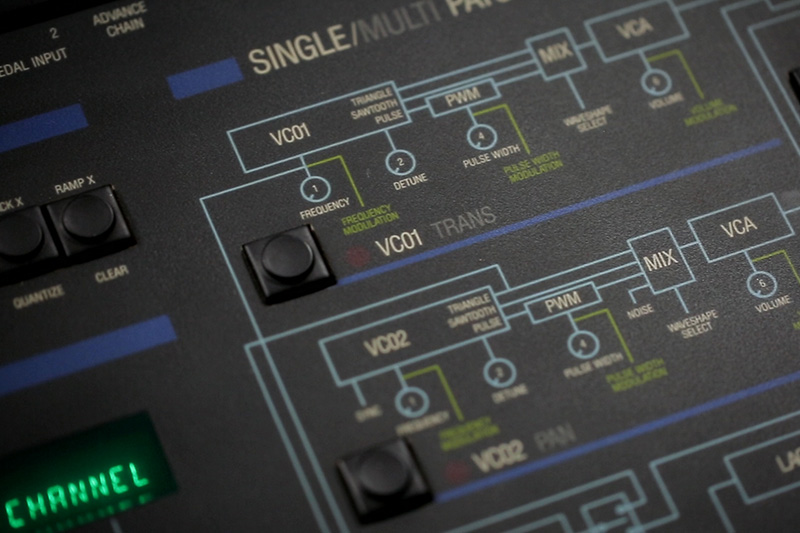
Unlike many modulation matrix-oriented synths, the Matrix-12 does not exactly have a dedicated page for assigning and adjusting modulation (though it does have something similar, which will be addressed in a bit). Instead, modulation programming is typically "destination-oriented," meaning that modulation is assigned in the detail pages for the destination itself, employing the line of buttons above the 40-character displays. For example, if you wanted to use EG2, for instance, to modulate the Frequency of VCO1:
- First navigate to VCO1's settings by pressing the VCO1 button in the Single Page Select section of the panel (on the right side of the instrument).
- In the Page modifier section, the top display will read "FREQ DETUNE - PW - VOL". Press the button immediately beneath FREQ.
- You are now navigated to page where modulation sources may be defined. Next, in the Modulation Source/X Select section (above the displays), press the button labeled ENVX.
- ENVX will flash in the modulation source position on the top Page Modifier display. Press "2" in the X Select section to select EG2.
- The encoder at the bottom of the Page Modifier section now controls the modulation depth from EG2 to VCO1's frequency. Valid values are -63 to 63, which represent -1x and 1x gain, respectively.
All other modulation can be defined in this way: simply use the Patch Page Select section to navigate to your destination, select the specific destination via the Page Modifier section, assign the modulation source using the Modulation Source/X Select section, and adjust modulation depth using the encoders in the Page Modifier section. While this takes a few steps, it is actually a fairly fast workflow—and once you get to know the inner workings of each module, the interface can be navigated fairly quickly.
 Panel control diagram from the Matrix-12 manual
Panel control diagram from the Matrix-12 manual
Of course, as you approach the limit of 20 modulation assignments, it can be difficult to keep track of where everything is routed. By navigating to the NAME page and then switching to Page 2 in the Page Modifier section, you can access a list of all current modulation assignments and even adjust modulation amounts and destinations. Using the first encoder, you can scroll through all current modulation assignments one at a time and simultaneously view the current Source, Amount, and Destination. You cannot select new sources from this page, but this can be a handy place to get an overview of your patch and fine-tune things once a basic patch has been set up.
With all this talk about the mechanics of modulation, though, it only makes sense that we should take a closer look at what the internal modulation sources are and how they work.
Envelopes and LFOs in the Matrix
Each voice in the Matrix-12 has five digital envelopes and five digital LFOs. But as you might expect by now, these aren't just generic modulation sources: each hides an interesting set of capabilities that lend themselves to multiple uses.
The Matrix-12's envelopes are all DADSRs—like typical ADSR envelopes with an added Delay stage at the beginning, used to delay the onset of the envelope. This can be particularly useful for creating multiple articulations when routing several envelopes to the same destination, or for creating particularly long, complex contours for particularly lively, evolving sounds. Each envelope features its own output VCA as well—so when routing the envelope to multiple destinations, you can use the VCA as a sort of "macro control" for the overall impact of that envelope throughout your patch.
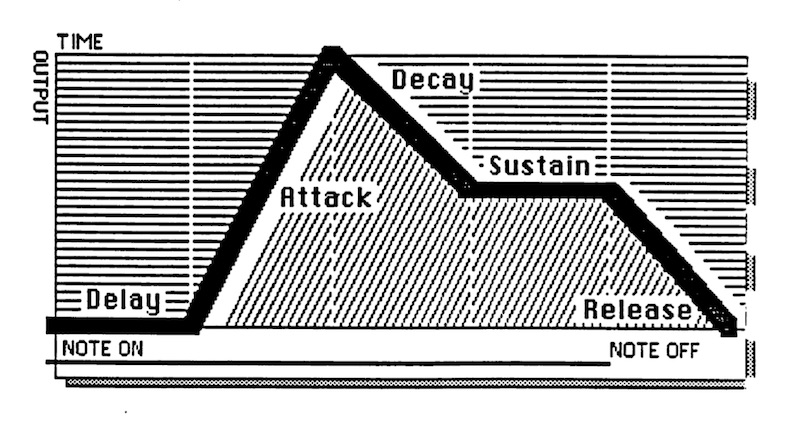 DADSR diagram from the Matrix-12 manual
DADSR diagram from the Matrix-12 manual
Envelopes can be set to reset when they receive new triggers or to continue from the same point in the cycle. Envelopes may also be set to "FREERUN" mode, in which they complete their entire cycle whether or not keys are held long enough to reach the sustain page. Similarly, you can set the envelopes to DADR mode, in which the sustain portion is skipped altogether, whether or not keys are held beyond the execution of the decay stage. Envelopes also can operate in Single or Multi modes, enabling easy access to legato or always-rearticulated playing styles internal to a voice. This of course is not terribly profound when using Matrix-12 as a polysynth, but can have useful implications if using a Multi patch or running all voices in unison (but more on that later).
One of the most interesting aspects of the Matrix-12's envelopes is that they need not be triggered by the keyboard (unlike most other polysynths of the era). Each envelope can be triggered from the keyboard (default), from the external trigger input jack on the back panel, or from any of the internal LFOs. Additionally, external and LFO-based triggers can be set to be gated or not gated, indicating whether they are active only when keys are pressed or always active. This is particularly interesting, because the Matrix-12 doesn't necessarily need to be controlled from a keyboard to make sound—and this is one of the aspects of the instrument that so captivated many users of the Xpander. Despite the fact the Xpander was itself keyboardless, it is possible to set it to create animated, generative textures using only LFOs to trigger the internal envelopes.
Another of the envelopes' interesting characteristics is that they can be extensively modulated: the duration of each segment is a valid modulation destination, meaning that the behavior of your envelopes can change based on any number of conditions: you could make higher notes shorter and lower notes longer, you could increase release time by using a performance lever, you could use random LFOs to dictate articulations...the possibilities are very nearly endless.
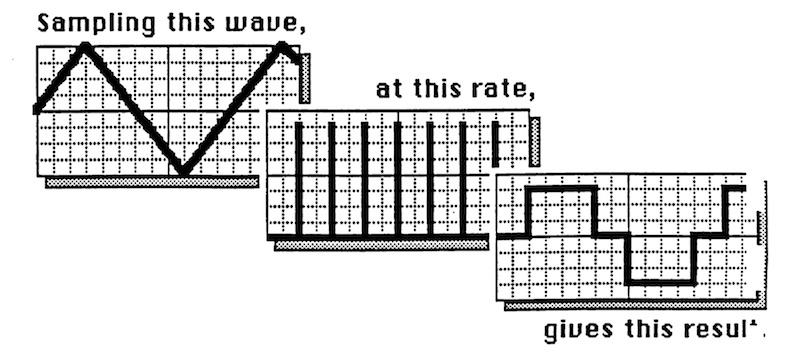
As with the envelopes, the Matrix-12's LFOs go a few steps beyond the typical modulation source. Each provides the expected triangle, square, upward saw, and downward saw, but also adds a continuously generated random signal and a faster random generator called Noise. Perhaps most interestingly, though, any given LFO can be set to "SAMPLE" mode, in which it acts as a true sample & hold, with a sample rate defined by the RATE parameter. Most any modulation source can be sampled by the LFOs, allowing you to turn any continuous modulation signal into a stepped signal. This can be great for creating stepped LFO shapes, random signals with rate modulation, and more.
The LFOs also feature a retrigger option (super cool when used in conjunction with the SAMPLE mode, for per-note parameter randomization) and their own output VCA, enabling the same sort of "macro" control described above with the envelopes. Interestingly, the LFOs also feature their own integrated lag generators—meaning that hard-edged LFO signals can be smoothed out without needing to occupy the general-purpose lag generator. This can be super useful for calming the potential edginess of square waves, random, noise, or the sample & hold modes to create smoother modulation.
Ramp Generators and Tracking Generators

Of course, there are even more novel modulation sources than the envelopes and LFOs at hand. The four Ramp generators are are something like single-stage, attack-only envelopes which can be triggered either from the keyboard or the LFOs. The Ramp generators are great when you need some aspect of the sound to swell in over time, without needing to occupy the somewhat more sophisticated envelope generators. A common application would be to modulate the amplitude of an LFO, gradually increasing the amount of vibrato or filter modulation, for instance. Alternatively, it could also be used to gradually increase FM depth, and more.
Perhaps one of the most interesting applications of the ramp generators, though, is to combine them with any of the three Tracking Generators. Tracking Generators are a fairly novel concept—one that has surfaced in few hardware instruments since. The tracking generators can be thought of like a mapping function or a transfer function, accepting input from a source and re-mapping input values to new output values that need not have a linear relationship to the input. The Matrix-12 accomplishes this by allowing users to define a five-point graph that maps input values to output values. When you navigate to a Tracking Generator page, you'll see six parameters: INPUT, POINT1, POINT2, POINT3, POINT4, and POINT5. By moving the encoders beneath each POINT, you can re-shape the mapping to suit your needs.
For instance, setting the points to 0, 15, 31, 47, and 63 respectively will result in a linear mapping of input to output: when the input is low, it produces a low value, when the input is high, it produces a high value, etc. Reversing these settings, though, will produce a different effect: if you set the points to 63, 47, 31, 15, and 0, the input will be inversely mapped to the output, effectively creating a phase-inverted, upside-down version of your input signal. By setting the points to nonlinear sequences of values, however, you can produce considerably more complex modulation shapes.
For instance, sending one of the ramp generators through a tracking generator will create an envelope of sorts—one that follows the shape you have defined with the tracking generator itself. Using a saw LFO as input, the tracking generator becomes a means of directly generating five-breakpoint complex modulation waveshapes. Using the keyboard as input, you can make certain aspects of the sound more or less prominent in different registers—or, mapping the keyboard through a tracking generator to pitch, you can create microtonal scales that change in shape and direction across the length of the keyboard. You can also send one tracking generator into another, creating cascading complexities that can quickly spiral out of control—to often amusing, exciting effect.
Multitimbral Behavior—Timbres Everywhere
With all of these sonic resources at their disposal, even a single timbre of these synths can sound animated and full. However, one of the coolest features of these instruments uncommon in modern designs is that they are extensively multi-timbral. In the last few years, it seems as if multi-timbral polysynths have come back into vogue, with devices like the Novation Summit, Moog One, and Sequential Prophet Rev2 allowing users to layer a limited number of timbres on top of one another. And while these are definite steps forward from strictly monotimbral designs, many instruments in the 1980s were somewhat more adventurous in their multitimbral capabilities.
In the Xpander and Matrix-12, every voice can be treated completely independently. These instruments make a distinction between "single" patches and "multi" patches. The bulk of sound editing tends to happen in single patches; single patches are where information about particular timbres is stored so that the instrument can recall specific sounds. Multi patches, though, store information about collections of sounds and how they are to be controlled. Multi patches can be comprised of up to twelve distinct timbres, or can assign a single timbre to multiple voices—and as we'll see, there are situations in which even assigning a single timbre to all voices can be a good choice.
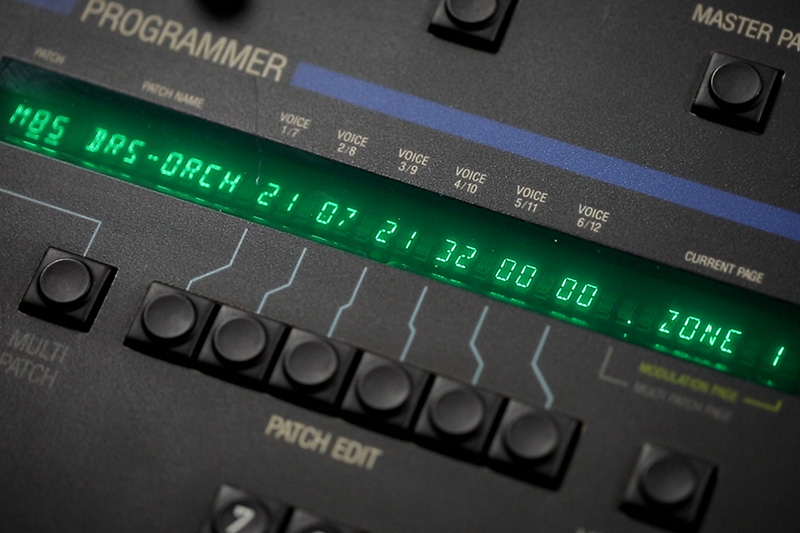 Patch Edit display on the Oberheim Matrix-12
Patch Edit display on the Oberheim Matrix-12
In multi patches, each voice can be assigned to accept control from any of 22 sources: 16 channels of MIDI input, and six user definable "Zones." The Zones are where much of the magic happens, enabling splits, layers, and overlapping selections of sounds across the keyboard. Zones are key ranges with user-definable MIDI note limits. By using the Voice Assign (V. Assign) page to assign specific single patches to different Zones, you can create a number of effects.
For example, if you wanted to create a six-voice layered bi-timbral sound, you would first assign the correct programs to each voice in the multi patch. Then, use V. Assign to assign voices 1–6 to Zone 1 and 7–12 to Zone 2. Set Zone 1 and Zone 2's limits to "36 to 96" (the full range of the keyboard). Similarly, you could create a tri-timbral layered sound by assigning three single patches to four voices each, and then assigning those groups of voices to three Zones which occupy the entire keyboard. To create splits rather than layers, you can just use multiple zones whose limits are directly adjacent to one another. The possibilities for combinations are nearly endless: sounds can overlap one another on the keyboard, individual voices can be set to respond only to external MIDI...there is no shortage of opportunity for finding novel ways of combining sounds.
Voice allocation within a Zone can also be defined. Many patches that use multiple timbres might aim to distribute polyphony evenly between these voices, or at least in such a way that each of the individual Zones employ voice stealing to keep the polyphony as seamless as possible. However, it is also possible to make a Zone play all of its voices in Unison. This is one of the potentially interesting reasons to make a Multi patch with a single timbre assigned to every voice: you can use this to create huge, twelve-voice unison sounds. Additionally, you could create unison sounds with multiple timbres—the options are extensive, to say the least.
In addition to managing the control source for individual voices, multi-patches also handle additional useful information for making sounds more easily join together into a coherent texture. Each voice can be separately set to a fixed transposition (in semitones), pan position, overall volume, vibrato amount, and detuning. In this way, you can create a chorus of sounds that pings between different positions in stereo space, shifting in register and loudness as they go. Or, you can simply use these tools to manage the levels and register of specific timbres relative to one another—making for an easily customizable means of creating huge sounds from electronic drum kits to synthesized orchestras, bass/key splits, and deep, slowly unfolding soundscapes.
It is not altogether common to find Xpanders or Matrix-12s—despite the fact that a good number were made, many of their owners have over time become very protective of these instruments because they can cover so much ground. And while they weren't quite enough to keep Oberheim afloat in the 1980s, these instruments have contributed significantly to Oberheim's long-term reputation: these are two of the most flexible polyphonic synthesizers ever made, providing years' worth of opportunity for experimentation. Whether you want 1980s synth orchestra sounds, huge basslines, lush ambient textures, or rampant generative sci-fi sound effects, they have you covered.
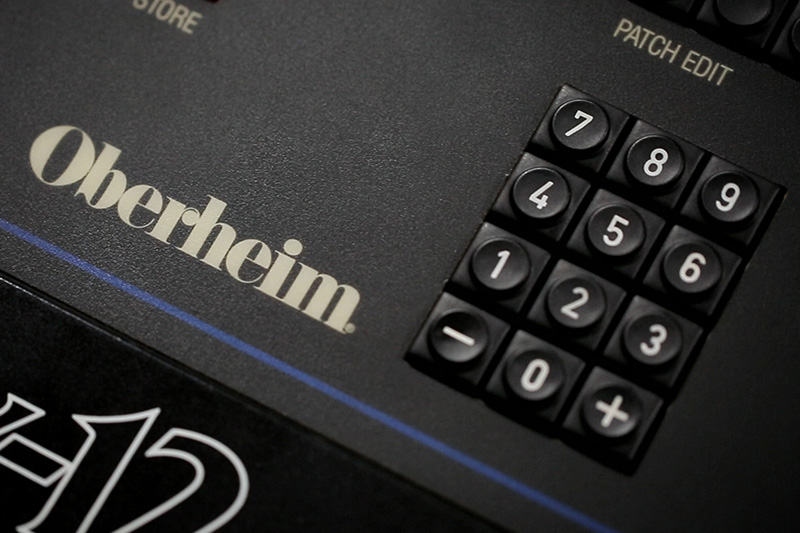
No modern synths are quite like these, though recently more and more instruments have begun to add multitimbral support (albeit not to quite the extent of these synths). The Eurorack world has taken advantage of some of these instruments' more idiosyncratic features. Doepfer's (now-discontinued) A-106-6 Xpander Filter, for instance, provides the same filter options as the Xpander and Matrix-12 in a single Eurorack module. Klavis's Flexshaper is a thorough adaptation of the Tracking Generator, providing a completely voltage-controllable five-breakpoint transfer function for bending voltages into completely new shapes (even up into audio rates). Arturia sought to directly recreate the Matrix-12 with their stunning Matrix-12V virtual instrument...and of course, the key innovation of these instruments—a digitally-controlled modulation routing system—has become a standard concept in countless synthesizers, virtual analog, true analog, digital, and software alike.
Originally overshadowed during a time of change in the synthesizer industry, the Xpander and Matrix-12 have earned a cult reputation as some of the most interesting and flexible analog synths ever made—and having spent some time with them, we have to agree that this reputation is well-deserved.







